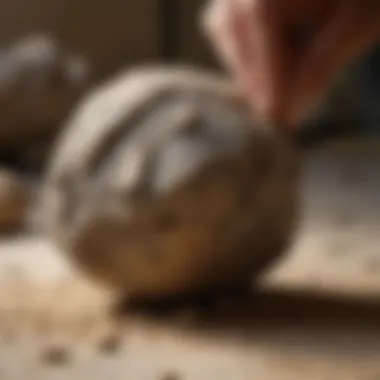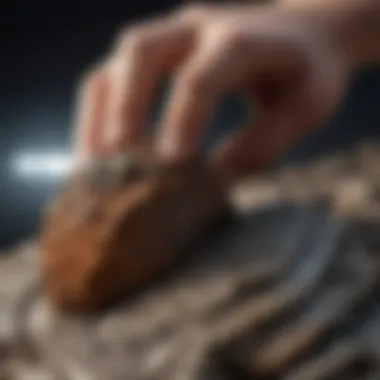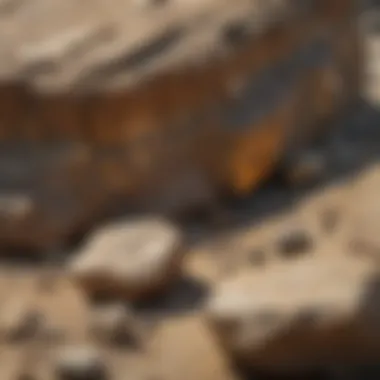Elevating Rock and Fossil Collecting Techniques with High Grit Sandpaper and Dremel Tools


Rock and Fossil Identification
Rock and fossil identification is a pivotal aspect of collecting geological specimens. Understanding the types of rocks and fossils and recognizing their unique characteristics are fundamental skills for enthusiasts in this field. By utilizing specialized tools for identification such as magnifying glasses, geologist hammers, and field guides, collectors can systematically classify and categorize their findings, contributing to a more in-depth comprehension of the geological world.
Collecting Tips and Techniques
For rock and fossil collectors, honing best practices and techniques is essential for effectively gathering specimens. Locating prime collecting sites involves research and exploration, leveraging geological maps, online resources, and local knowledge to identify promising areas rich in geological formations. Understanding how to safely extract specimens without causing damage requires precision tools like chisels, brushes, and packaging materials to carefully handle and transport finds for further study and analysis.
Preservation and Display
Preserving rocks and fossils ensures their longevity for continued study and enjoyment. Techniques such as cleaning with gentle brushes, stabilizing with consolidants, and sealing with protective coatings are crucial for maintaining the integrity of specimens. Proper storage methods involve utilizing acid-free containers, cotton or foam padding, and consistent environmental conditions to prevent degradation over time. When it comes to displaying collections, enthusiasts can get creative by arranging specimens in shadow boxes, using risers for visual interest, and incorporating labels with relevant information to showcase the beauty and diversity of their findings.
Geological Insights
Delving into geological insights offers collectors a deeper appreciation for the Earth's history and evolution. Exploring different geological formations and processes illuminates the dynamic forces at play in shaping the planet's landscape over millennia. Understanding the historical significance of rocks and fossils sheds light on past ecosystems, climate conditions, and evolutionary pathways, providing valuable context for interpreting geological specimens. Notable discoveries in the field serve as reminders of the constant exploration and discovery within the realm of rock and fossil collecting, inspiring continued curiosity and investigation into the mysteries of the natural world.
Introduction
Rock and fossil collecting techniques are being revolutionized by the integration of high grit sandpaper and Dremel tools. The utilization of these advanced tools opens up a realm of possibilities for enthusiasts seeking to refine their collection practices. By exploring innovative methods and approaches, collectors can enhance the quality of their specimens through precise shaping, intricate detailing, and meticulous polishing.
Understanding the Significance of High Grit Sandpaper and Dremel
Benefits of High Grit Sandpaper in Geology
High grit sandpaper plays a pivotal role in geology by offering unparalleled precision and control in refining rock and fossil specimens. Its ultra-fine abrasive surface facilitates smooth finishes, making it ideal for achieving professional-quality results. The key characteristic of high grit sandpaper lies in its ability to delicately smooth rough surfaces without compromising the specimen's integrity. This ensures that collectors can reshape and refine geological materials with utmost accuracy and finesse, elevating the overall aesthetic appeal of their collections.
Advantages of Using Dremel Tools in Rock and Fossil Preparation
Dremel tools are indispensable for rock and fossil preparation, providing unparalleled versatility and efficiency in shaping and detailing specimens. The key characteristic of Dremel tools is their precision-engineered attachments that enable collectors to execute intricate cuts and engravings with remarkable accuracy. This precision enhances the overall quality of specimen preparation, allowing for customized shapes and designs that elevate the visual impact of the collection. The unique feature of Dremel tools lies in their ability to seamlessly blend creativity with technical proficiency, making them an essential choice for enthusiasts looking to refine their collection techniques.
Key Considerations Before Diving into Advanced Techniques
Safety Measures for Working with High Grit Sandpaper and Dremel
Prioritizing safety is paramount when utilizing high grit sandpaper and Dremel tools. Implementing proper safety measures, such as wearing protective gear and working in well-ventilated spaces, is essential to prevent injuries and ensure a secure working environment. The key characteristic of observing safety protocols is the mitigation of potential hazards associated with abrasive materials and high-speed rotary tools. By adhering to safety guidelines, collectors can safeguard themselves and prolong the longevity of their tools, fostering a conducive workspace for creative exploration.


Choosing the Right Grit Levels for Different Geological Materials
Selecting the appropriate grit levels is crucial for optimizing the efficiency of sanding and polishing procedures on various geological materials. The key characteristic of choosing the right grit levels lies in understanding the intrinsic properties of the specimens and matching them with the corresponding abrasive coarseness. By tailoring the grit levels to the material's hardness and texture, collectors can achieve optimal results during the shaping and finishing processes. This approach not only streamlines the workflow but also enhances the overall quality of the final product, allowing for a more refined and professional outcome.
Setting Up Your Workspace for Optimal Results
Organizing Tools and Materials
Efficient organization of tools and materials is fundamental to maximizing productivity and ensuring smooth workflow during rock and fossil preparation. The key characteristic of organizing tools and materials is the systematic arrangement and accessibility of essential equipment, promoting seamless transitions between tasks. By structuring the workspace effectively, collectors can streamline their operations and minimize interruptions, facilitating a conducive environment for meticulous detailing and polishing. This meticulous approach enhances efficiency and precision, setting the stage for high-quality specimen preparation.
Ensuring Proper Ventilation and Lighting
Ensuring adequate ventilation and lighting is essential for creating an optimal workspace conducive to detailed rock and fossil preparation. Proper ventilation helps dissipate dust particles generated during sanding and polishing, promoting a clean and healthy environment for work. The key characteristic of ventilation and lighting lies in enhancing visibility and air quality, facilitating precise and controlled manipulation of tools. By prioritizing adequate lighting, collectors can inspect specimens with clarity and accuracy, ensuring consistent and refined results in their collection practices.
Application of High Grit Sandpaper in Rock and Fossil Collecting
High Grit Sandpaper is a crucial tool in the realm of rock and fossil collecting, revolutionizing the way enthusiasts shape and refine their geological specimens. By utilizing high grit sandpaper, collectors can achieve unparalleled smoothness and precision in their artifacts, elevating the aesthetic appeal and scientific value of their collections. The application of high grit sandpaper opens up a world of possibilities for enthusiasts, allowing them to uncover hidden beauty in rocks and fossils that were previously inaccessible. Through this article, we aim to explore the intricate details of how high grit sandpaper can enhance the rock and fossil collecting experience, offering insights that cater to the discerning needs of collectors seeking to boost their expertise and proficiency.
Smoothing Rough Edges and Surfaces
Techniques for Achieving Professional Finish
When it comes to smoothing rough edges and surfaces, employing specific techniques can make a significant difference in the final outcome of geological specimens. Professional finish techniques involve meticulous attention to detail, consistent pressure application, and a thorough understanding of the material being worked on. By mastering these techniques, collectors can elevate their artifacts to a level of refinement that exudes professionalism and expertise. The key characteristic of professional finish techniques lies in their ability to transform rough, uneven surfaces into polished and flawless creations, enhancing the overall visual appeal and scientific clarity of the specimens. One must pay close attention to detail to avoid any imperfections or inconsistencies that may detract from the specimen's quality, making professional finish techniques a popular choice among enthusiasts looking to showcase their collections with precision and finesse.
Avoiding Common Mistakes in Sanding
In the realm of sanding, avoiding common mistakes is paramount to achieving optimal results when working with geological specimens. Common mistakes such as uneven pressure distribution, incorrect sandpaper grit selection, or excessive sanding can compromise the integrity and aesthetics of the artifact. By understanding and avoiding these pitfalls, collectors can ensure that their sanding process contributes positively to the final outcome of the specimen. The unique feature of focusing on avoiding common mistakes lies in its ability to preserve the natural beauty and structural integrity of rocks and fossils, ensuring that the collector's efforts culminate in a masterpiece free of imperfections or blemishes. Recognizing and addressing these common mistakes is essential in the rock and fossil collecting journey, as it empowers enthusiasts to refine their skills and techniques for superior results.
Creating Intricate Patterns and Designs
Precision Sanding for Artistic Results
Precision sanding plays a pivotal role in crafting intricate patterns and designs on geological specimens, offering collectors a method to express their artistic vision with finesse and accuracy. By honing the skill of precision sanding, enthusiasts can manipulate the texture and appearance of rocks and fossils to showcase unique patterns and designs that highlight the natural beauty of the materials. The key characteristic of precision sanding lies in its ability to enhance the artistic allure of geological specimens, granting collectors the freedom to sculpt and mold their creations according to their creative impulses. This approach is a beneficial choice for collectors seeking to add a touch of artistry to their collections, as precision sanding allows for controlled alterations that preserve the essence of the original specimen while infusing it with artistic flair.
Innovative Approaches to Texturing


Exploring innovative approaches to texturing introduces a realm of creativity and experimentation in rock and fossil collecting that transcends traditional techniques. By embracing unconventional texturing methods, collectors can push the boundaries of design and aesthetic appeal, crafting specimens that stand out for their uniqueness and originality. The key characteristic of innovative texturing lies in its capacity to spark imagination and ingenuity, encouraging enthusiasts to think outside the box and explore new possibilities in specimen preparation. This approach is a popular choice for collectors looking to infuse their artifacts with a sense of individuality and innovation, as innovative texturing techniques allow for unconventional textures and patterns that captivate the viewer's interest and curiosity.
Polishing Techniques for Enhanced Aesthetics
Utilizing High Grit Sandpaper for Luster
Utilizing high grit sandpaper for luster is a game-changing technique in the polishing process of geological specimens, imparting a brilliant shine and smoothness that elevates the overall aesthetics of the artifacts. By harnessing the power of high grit sandpaper, collectors can achieve a lustrous finish that enhances the visual appeal and market value of their specimens. The key characteristic of utilizing high grit sandpaper for luster lies in its transformative effect on the surface of rocks and fossils, creating a dazzling sheen that reflects light and magnifies the intricate details of the material. This technique is a beneficial choice for collectors aiming to present their artifacts in the best possible light, as it accentuates the natural beauty and geological features of the specimens, making them irresistible to both enthusiasts and connoisseurs.
Finishing Touches for a Glossy Shine
Finishing touches are the final steps in the polishing process that ensure a glossy shine and impeccable quality in geological specimens, leaving a lasting impression on viewers and collectors alike. By meticulously attending to the finishing touches, collectors can refine their artifacts to perfection, smoothing out any imperfections or irregularities to achieve a flawless end result. The unique feature of finishing touches lies in their ability to add a layer of sophistication and refinement to geological specimens, signaling that every detail has been meticulously considered and perfected. This approach offers advantages in enhancing the overall presentation and desirability of the artifacts, making them desirable additions to any collection or display for their impeccable finish and attention to detail.
Utilizing Dremel Tools in Geological Specimen Preparation
The inclusion of the section on Utilizing Dremel Tools in Geological Specimen Preparation is a crucial aspect of this article. Emphasizing the significance of utilizing Dremel tools in the field of geological specimen preparation adds a profound layer of depth and intricacy to rock and fossil collecting techniques. By integrating Dremel tools into the process, enthusiasts can achieve precision and finesse that were previously unattainable with traditional methods. This section will delve into the specific methodologies, benefits, and considerations surrounding the utilization of Dremel tools in enhancing the overall quality of geological specimen preparation.
Precision Cutting and Shaping
Choosing the Right Dremel Attachments for Various Tasks
The selection of suitable Dremel attachments for different tasks holds paramount importance in the realm of geological specimen preparation. Each attachment serves a specific purpose, allowing collectors to exercise precision and control over the cutting and shaping processes. By meticulously choosing the appropriate attachments, enthusiasts can streamline their workflow and achieve impeccable results. The versatility of Dremel attachments enables users to adapt to various geological materials, making this selection process a critical aspect of the rock and fossil collecting journey.
Tips for Creating Customized Shapes
Generating customized shapes with Dremel tools demands attention to detail and a creative approach. This facet not only showcases the artisanal skills of collectors but also adds a unique flair to their specimens. Incorporating personalized shapes enhances the aesthetic appeal of geological specimens, setting them apart from conventional collections. By exploring different techniques and honing their craft, enthusiasts can elevate their expertise in shaping rocks and fossils with unparalleled finesse and originality.
Detailing and Engraving Techniques
Enhancing Fossil Features with Dremel
The ability to enhance fossil features using Dremel tools opens up a realm of possibilities in geological specimen preparation. By delicately detailing and accentuating key elements of fossils, collectors can breathe new life into ancient artifacts. This technique not only preserves the integrity of the specimens but also amplifies their visual impact, making them a standout feature in any collection. The nuanced approach to enhancing fossil features through Dremel tools exemplifies the meticulous attention to detail that defines expert rock and fossil collectors.
Intricate Engraving Methods for Rocks
Implementing intricate engraving methods for rocks amplifies the storytelling aspect of geological specimens. Engraving serves as a means of etching history onto the surface of rocks, creating a narrative that captivates and intrigues viewers. By leveraging Dremel tools for engraving, collectors can add layers of complexity and symbolism to their displays, fostering a deeper appreciation for the geological wonders they possess. This section will explore the technique's nuances, benefits, and potential challenges, providing a comprehensive understanding of the art of rock engraving.


Final Finishing with Dremel
Buffing and Polishing for Professional Results
The final finishing touches achieved through buffing and polishing with Dremel tools elevate geological specimens to professional standards. By refining the surface texture and enhancing the luster of rocks and fossils, collectors can imbue their specimens with a remarkable sheen that exudes sophistication. This process not only enhances the aesthetics but also acts as a testament to the dedication and craftsmanship of the collector. The meticulous buffing and polishing techniques outlined in this section will empower enthusiasts to achieve flawless results in their rock and fossil collections.
Sealing and Protecting the Specimens
Securing the longevity of geological specimens through effective sealing and protection measures is paramount in the world of rock and fossil collecting. By safeguarding their prized possessions against environmental factors and wear, collectors can ensure the preservation of these treasures for generations to come. The application of protective coatings and proper storage practices will be explored in detail, equipping enthusiasts with the knowledge and tools needed to maintain the integrity and beauty of their rock and fossil collections.
Maintenance and Care Tips for Longevity of Tools and Specimens
Maintaining high grit sandpaper and Dremel tools is crucial for preserving their effectiveness and durability. These tools are essential for rock and fossil collectors, making proper care a vital aspect of their hobby. By investing time and effort in maintenance, collectors can ensure long-term use and optimal performance. Regular cleaning, lubrication, and storage are key elements to consider. Cleaning sandpaper helps prevent buildup, which can affect its sanding capabilities. Proper lubrication of Dremel tools keeps them running smoothly and extends their lifespan. Storing both sandpaper and Dremel tools in dry, clean areas away from moisture and dust is essential to prevent damage and ensure their longevity.
Cleaning and Storing High Grit Sandpaper
Preventing Damage and Contamination
Preventing damage and contamination of high grit sandpaper is paramount to maintaining its effectiveness. By keeping sandpaper free from dirt and debris, collectors can ensure consistent and precise sanding results. Avoiding moisture exposure is crucial, as dampness can cause the grit to deteriorate quickly. Regularly inspecting the sandpaper for wear and tear and replacing it when necessary helps prevent any damage that could transfer onto geological specimens during the sanding process.
Proper Storage Techniques
Proper storage techniques play a significant role in the longevity of high grit sandpaper. Storing sandpaper flat or rolled in a protective case prevents bends or creases that can impact its sanding efficiency. Additionally, keeping sandpaper in a cool, dry place away from direct sunlight helps maintain its grit integrity. Using labeled containers or organizers for different grit levels aids in easy access and prevents mix-ups, ensuring the right sandpaper is used for specific tasks.
Maintaining Dremel Tools for Optimal Performance
Regular Cleaning and Lubrication
Regularly cleaning and lubricating Dremel tools enhances their performance and extends their lifespan. Removing dust, debris, and buildup from attachments and components prevents jamming or slowing down during operation. Lubricating moving parts with the appropriate oil or grease keeps the tools running smoothly and reduces friction, leading to more precise cuts and engravings. Following the manufacturer's instructions for cleaning and lubrication intervals is crucial for maintaining optimal performance.
Replacing Parts and Attachments
Replacing worn-out or damaged parts and attachments is essential for the continued functionality of Dremel tools. Inspecting components regularly allows collectors to identify any signs of wear or breakage. Promptly replacing these parts prevents further damage to the tool and ensures safe usage. Using genuine replacement parts recommended by the manufacturer guarantees compatibility and performance. Keeping spare attachments on hand is beneficial for uninterrupted work sessions and enables quick changes for different tasks.
Preservation Methods for Finished Specimens
Protective Coatings for Longevity
Applying protective coatings to finished geological specimens enhances their durability and aesthetic appeal. These coatings act as a barrier against environmental factors that may cause deterioration or discoloration over time. Choosing the right type of coating, such as varnish or sealant, depends on the specific properties of the specimen and desired finish. Proper application following guidelines from experts or product instructions ensures even coverage and long-lasting protection.
Display and Storage Recommendations
Displaying and storing finished specimens properly is crucial for their preservation and presentation. Using display cases or shelves with adjustable lighting and controlled humidity levels showcases specimens while protecting them from dust and light damage. Organizing specimens by type or origin makes it easier to locate specific pieces and prevents accidental damage during handling. Implementing rotation schedules for displayed specimens helps evenly distribute exposure and minimizes the risk of fading or deterioration. Following recommended storage practices, such as storing specimens in acid-free paper or boxes, ensures their longevity and maintains their value.







